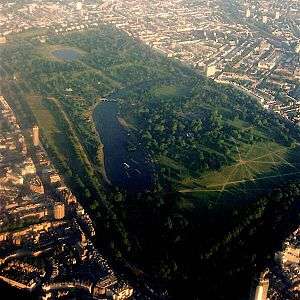Clissold Park
| Clissold Park | |
|---|---|
 | |
| Location | Stoke Newington, London, England, United Kingdom |
| Coordinates | 51°33′40″N 0°5′17″W / 51.56111°N 0.08806°WCoordinates: 51°33′40″N 0°5′17″W / 51.56111°N 0.08806°W |
| Area | 22.57 hectares (55.8 acres) |
| Created | 1889 |
| Operated by | London Borough of Hackney |
Clissold Park is a designated community park (22.57 hectares (55.8 acres))[1] in Stoke Newington, within the London Borough of Hackney.[2] Its facilities include children's playgrounds, sports fields, a bowling green, tennis courts, the café and some other attractions including terrapins in its lakes, as well as deer, quail, and rabbits. The park also comprises remains of the New River, and the Capital Ring has some of its paths running through a small section of the park.
History

Clissold House (formerly Paradise House) was built, in the latter half of the 18th century, for Jonathan Hoare,[3] a City merchant, Quaker, philanphropist and anti-slavery campaigner. (His brother, Samuel, half-brother of Sir Joseph Hoare Bt, was one of the founders of the Society for Effecting the Abolition of the Slave Trade.) The park was created to be his idyll, and the stretch of water which wends its way around the house was once part of the New River, a canal that supplied London with clean water from Hertfordshire.[4]
After 1811, the estate passed, via the Crawshaw family to Augustus Clissold; but, when he died in 1882, developers closed in, and activists John Runtz and Joseph Beck (members of the Metropolitan Board of Works)[5] who convinced the authorities to open it as a public space in 1889. A fountain was erected in 1890 commemorating them; later, the park’s two wildlife ponds were named after them too. As 'Beckmere' and 'Runtzmere'.[4]
Restoration
Clissold House, the former villa within the park, is a Grade II listed building; the house serves as refreshment rooms and as an event location.[6] In 2007, Clissold Park was voted the Heart of Hackney, in an I Love Hackney Poll organised by Hackney Council. On 30 March 2007 the Heritage Lottery Fund announced the award of a development grant to put forward a bid for a full £4.5 million Park Restoration Grant.[7] The work should restore the park and house to its original 18th-century design.
Work on the Clissold Park and House Restoration Project commenced in January 2010, and over the next two years an estimated £8.9 million[8] was spent upgrading the historic Clissold house and its surrounding parkland. Funding was received from the Heritage Lottery Fund, the Big Lottery Fund, and Hackney Council. Plans[9] for the park included:
- Restoring the Grade II listed Clissold House
- Restoring a section of the New River
- Extensive maintenance to the two park lakes
- Renovating the current animal enclosures
- Creating a new play and wheels park area.
Clissold Park received a Green Flag award in July 2008.[10] Clissold House was added to the English Heritage 'Heritage at Risk Register' in 1991 but removed in 2012 following the completion of the restoration programme.[11]
Transport
There are no London Underground stations nearby, but within one mile are Manor House, Finsbury Park and Arsenal. The nearest railway stations are Canonbury and Stoke Newington.
In popular culture
- Clissold Park, and its pond, feature in the Hank Wangford song: "Jogging with Jesus".
- The album Ham by London-band The Chap features a song entitled: "Clissold Park".
- The London-based Astrophonica record label features a song by label owners Fracture & Neptune, titled "Clissold" named after the Park.
- In Nick Hornby's novel Slam, the character Sam and his girlfriend Alicia often go to Clissold Park.
- The Aphex Twin track 19 [Slo]w early morning clissold sunrise is part named after the park.
References
- ↑ "Assets Document SINC [Site of Interest for Nature Conservation] spreadsheet" (PDF). Hackney Council. Hackney Council. n.d. Retrieved 29 September 2013.
- ↑ Clissold Park: A Short History (Clissold Park User Group) accessed 20 Sept 2009
- ↑ Quaker history page
- 1 2 http://www.timeout.com/london/features/5576/2.html
- ↑ "Clissold Park, Hackney". hidden-london.com. Retrieved 10 February 2013.
- ↑ www.clissoldpark.com
- ↑ BBC News 16 April 2007 accessed 17 April 2007
- ↑ Clissold Park User Group accessed 7 April 2010
- ↑ Hackney Council Clissold Restoration Project accessed 7 April 2010
- ↑ Hackney Today 188 21 July 2008
- ↑ "Heritage at Risk: latest findings". English Heritage.
External links
| Wikimedia Commons has media related to Clissold Park. |
